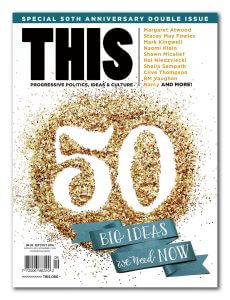Hey, Canada: Pay your artists fair wages
Artists deserve fair pay for their work, too.
Thomas Colford@TLColford
 For our special 50th anniversary issue, Canada’s brightest, boldest, and most rebellious thinkers, doers, and creators share their best big ideas. Through ideas macro and micro, radical and everyday, we present 50 essays, think pieces, and calls to action. Picture: plans for sustainable food systems, radical legislation, revolutionary health care, a greener planet, Indigenous self-government, vibrant cities, safe spaces, peaceful collaboration, and more—we encouraged our writers to dream big, to hope, and to courageously share their ideas and wish lists for our collective better future. Here’s to another 50 years!
For our special 50th anniversary issue, Canada’s brightest, boldest, and most rebellious thinkers, doers, and creators share their best big ideas. Through ideas macro and micro, radical and everyday, we present 50 essays, think pieces, and calls to action. Picture: plans for sustainable food systems, radical legislation, revolutionary health care, a greener planet, Indigenous self-government, vibrant cities, safe spaces, peaceful collaboration, and more—we encouraged our writers to dream big, to hope, and to courageously share their ideas and wish lists for our collective better future. Here’s to another 50 years!
In Canada, a lot of work has been done to develop two great organizations: There’s the Canadian Actor’s Equity Association (CAEA or Equity), an association that operates not unlike a union; and the Alliance of Canadian Cinema, Television and Radio Artists (ACTRA), a union with a 70-yearplus history in Canada—anything that happens on TV, film, or radio falls into its territory. Both of these acronyms do tremendous work for artists of almost every discipline, ensuring they get treated fairly and compensated accordingly. However, there is a grey area of non-union work.
When it comes to dance in Canada almost everything else falls under non-union work. A lot of stage productions and film work identify themselves as non-union, generally because their budgets are not large enough to accommodate and abide by the standards set by ACTRA or CAEA. That is totally understandable. We need these smaller non-union jobs to help artists gain the experience and momentum to go from their humble beginnings to the expert professionals who can create the shows and music we love.
The issue presents itself when a huge company, brand, and/or musician puts a call out for non-union work. In most cases the wage is nearly non-existent (or actually non-existent). For example, at Toronto’s 2015 Pan Am games, the opening ceremonies featured many dazzling acts and 60 local professional dancers. These dancers had nearly 150 hours of rehearsal. How much were they compensated? A transit pass for the month of June—valued at $140. You can’t make this up. Surely somewhere in the $2.5-billion dollar budget (that had room for Cirque du Soleil, international choreographers, Kanye West, and a second fully compensated cast of dancers) there must have been room to pay the opening ceremonies cast—and if there wasn’t, maybe they shouldn’t have been hired.
Many dancers are routinely hired by big name acts for far, far less than minimum wage. Artists create culture, and without culture who are we? What would life be without arts and entertainment? There are many groups, individuals, and organizations fighting to improve conditions for dancers, but we can’t do it alone. We need the public to support our goals. The harder it is for artists to get paid properly, the harder it is for them to create. A great number of dance artists vacate Canada because they know they can be better compensated abroad. We need to fight for our artists so they are fairly compensated at home and feel valued here in Canada. We need to stand by them so they feel supported when they tell these offers of opportunity and exposure: “I’m worth more.”
Photo courtesy of Thomas L. Colford/Instagram
An actor, dancer, and entrepreneur originally from Nova Scotia, Thomas Colford has pursued his dreams to credits including Janet Jackson, Center Stage: On Pointe, and Imagine Dragons.